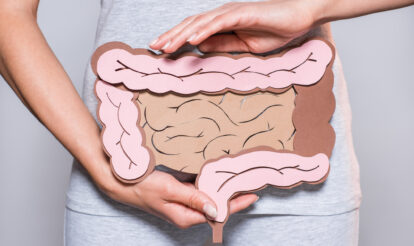
Fit inside and out: How exercise supports gut health
Fit inside and out: How exercise supports gut health

Hitting the pavement, lifting weights, or saluting the sun are all great ways to keep fit. But something you might not know is that those activities are also keeping your gut in good shape.
While we most often think of diet as the cornerstone of gut health, recent research shows that exercise is just as beneficial.
Your gut microbiome is a key player in almost every bodily function, from your immune defences to your central nervous system. Gut bacteria have a major influence on mood, behaviour, brain function, and energy levels. An imbalance in the microbiome – known as dysbiosis – can affect not only digestion but many other aspects of physical and mental health.[1]
Physical activity has a clear influence on the gut microbiome, improving both the quality and abundance of key microbial species..
The gut microbiome of athletes differs markedly from that of non-athletes, both in composition and function. Physical activity has been shown to increase microbial diversity and enhance the production of beneficial substances such as short-chain fatty acids (SCFAs), which influence everything from inflammatory processes to neurotransmitter levels.[2]
Here’s how regular exercise can contribute to a healthier, happier gut.
- Increases microbial diversity
Exercise helps to increase the range and abundance of different bacterial species in the gut. As different microbes play different roles in the body, greater diversity assists with energy production, healthy blood sugar levels, immune defences, and more.[3] Active people are shown to have greater populations of beneficial bacteria such as Clostridiales, Roseburia, Lachnospiraceae, and Erysipelotrichaceae genera.[4] - Encourages SCFA production
Regular physical activity enhances the growth of species that produce SCFAs such as butyrate, acetate, and propionate. A study comparing the microbial diversity of athletes and non-athletes found a strong relationship between aerobic fitness (VO2max) and the quantity of SCFAs in their gut, indicating that more aerobically fit humans produce higher rates of SCFAs.[5]
These valuable substances help to strengthen the gut barrier, manage inflammation, and influence neurotransmitter levels via the gut-brain axis.[6] SCFAs also help regulate immune responses and help to protect organs, including the heart, brain, and kidneys.[7] - Reduces bowel transit time
The mechanical impact of exercise improves gut motility and reduces the time it takes for food to move through the large intestine, helping to maintain bowel regularity and prevent constipation.Regular bowel movements help maintain a healthy pH in the colon, supporting the growth and survival of beneficial bacteria.[8] - Strengthens the gut barrier
Exercise increases the production of anti-inflammatory cytokines such as IL-10 and IL-1Ra, which play a vital role in inflammation and tissue repair. SCFAs also provide an energy source for cells lining the colon, thereby supporting the integrity of the gut lining and preventing leaky gut syndrome, which is often associated with irritable bowel syndrome.[9]
Exercise may also stimulate beneficial adaptations that enhance the resilience of the gut barrier. Regular exercise reduces the ‘heat shock’ response of the gut, which helps to protect the tight junctions between intestinal cells. In this way, exercise acts as a mild stressor that strengthens the gut barrier over time.[10]
What is the best exercise for gut health?
Different forms of physical activity can have different effects on microbiota, with both high- and low-impact exercise providing benefits.
Endurance exercise (such as running, cycling, or swimming for an extended period) triggers production of SCFA-producing bacteria, which help to maintain blood sugar during prolonged activity and reduce oxidative stress. Aerobic activity also enhances the diversity and abundance of major genera, including Lactobacillus and Bifidobacterium.[11]
Resistance training lowers zonulin – a marker of gut permeability – and increases mucin, the substance that forms a protective mucus layer in the gut. Both of these functions can help to reduce inflammation.[12]
Aerobic or core strengthening exercise can also stimulate intestinal muscle contractions, increasing blood flow to the digestive tract, and, in turn, reduces water absorption from the stool, resulting in softer, easier-to-pass stool.[13]
Combining both forms of aerobic and resistance exercise can therefore provide synergistic benefits, resulting in more comprehensive improvements in microbiome composition and function.[14]
Gentle forms of exercise, such as walking or yoga, help regulate cortisol levels and may create a more favourable environment for beneficial gut bacteria. A 2025 study found that a yoga meditation retreat combined with a vegetarian diet enriched the gut microbiome significantly within just nine days.[15]
The importance of balance
Whether you’re a lifelong fitness addict or just starting out, a regular exercise routine can provide powerful benefits within a relatively short period. One study involving previously sedentary men and women who began a moderate daily exercise routine showed that they developed greater microbial diversity and increased quantities of beneficial bacteria within just six weeks.[16]
But remember: moderation is key. Excessive or prolonged training without adequate recovery may disrupt the microbiome and damage the gut lining. Intense endurance exercise has been shown to increase levels of stress hormones and allow endotoxins to move to the gastrointestinal tract, triggering inflammation and intestinal permeability.[17]
Similarly, a study found that ‘forced’ exercise can act as a stressor that potentially disrupts microbial balance and exacerbates intestinal inflammation. Voluntary running, on the other hand, tends to produce more evenly distributed bacterial populations and reduce inflammation.[18]
Listen to your body, start where you are, and build gradually. Within weeks, your gut – like the rest of your body – will start to show the benefits.
This information is provided for educational purposes only and is not a substitute for professional medical advice. Always seek the guidance of your physician or qualified healthcare provider with any questions you may have regarding your health or a medical condition.
References
[1] Martinez, J. E., Kahana, D. D., Ghuman, S., Wilson, H. P., Wilson, J., Kim, S. C. J., Lagishetty, V., Jacobs, J. P., Sinha-Hikim, A. P., & Friedman, T. C. (2021). Unhealthy Lifestyle and Gut Dysbiosis: A Better Understanding of the Effects of Poor Diet and Nicotine on the Intestinal Microbiome. Frontiers in endocrinology, 12, 667066. https://doi.org/10.3389/fendo.2021.667066
[2] Mitchell, C. M., Davy, B. M., Hulver, M. W., Neilson, A. P., Bennett, B. J., & Davy, K. P. (2019). Does Exercise Alter Gut Microbial Composition? A Systematic Review. Medicine and science in sports and exercise, 51(1), 160–167. https://doi.org/10.1249/MSS.0000000000001760
[3] Portincasa, P., Bonfrate, L., Vacca, M., De Angelis, M., Farella, I., Lanza, E., Khalil, M., Wang, D. Q., Sperandio, M., & Di Ciaula, A. (2022). Gut Microbiota and Short Chain Fatty Acids: Implications in Glucose Homeostasis. International journal of molecular sciences, 23(3), 1105. https://doi.org/10.3390/ijms23031105
[4] Monda, V., Villano, I., Messina, A., Valenzano, A., Esposito, T., Moscatelli, F., Viggiano, A., Cibelli, G., Chieffi, S., Monda, M., & Messina, G. (2017). Exercise Modifies the Gut Microbiota with Positive Health Effects. Oxidative medicine and cellular longevity, 2017, 3831972. https://doi.org/10.1155/2017/3831972
[5] Estaki, M., Pither, J., Baumeister, P., Little, J. P., Gill, S. K., Ghosh, S., Ahmadi-Vand, Z., Marsden, K. R., & Gibson, D. L. (2016). Cardiorespiratory fitness as a predictor of intestinal microbial diversity and distinct metagenomic functions. Microbiome, 4(1), 42. https://doi.org/10.1186/s40168-016-0189-7
[6] Li, C., Li, J., Zhou, Q., Wang, C., Hu, J., & Liu, C. (2024). Effects of Physical Exercise on the Microbiota in Irritable Bowel Syndrome. Nutrients, 16(16), 2657. https://doi.org/10.3390/nu16162657
[7] Du, Y., He, C., An, Y., Huang, Y., Zhang, H., Fu, W., Wang, M., Shan, Z., Xie, J., Yang, Y., & Zhao, B. (2024). The Role of Short Chain Fatty Acids in Inflammation and Body Health. International journal of molecular sciences, 25(13), 7379. https://doi.org/10.3390/ijms25137379
[8] Mohr, A. E., Jäger, R., Carpenter, K. C., Kerksick, C. M., Purpura, M., Townsend, J. R., … Antonio, J. (2020). The athletic gut microbiota. Journal of the International Society of Sports Nutrition, 17(1). https://doi.org/10.1186/s12970-020-00353-w
[9] Aleman, R. S., Moncada, M., & Aryana, K. J. (2023). Leaky Gut and the Ingredients That Help Treat It: A Review. Molecules (Basel, Switzerland), 28(2), 619. https://doi.org/10.3390/molecules28020619
[10] Donati Zeppa, S., Agostini, D., Gervasi, M., Annibalini, G., Amatori, S., Ferrini, F., Sisti, D., Piccoli, G., Barbieri, E., Sestili, P., & Stocchi, V. (2019). Mutual Interactions among Exercise, Sport Supplements and Microbiota. Nutrients, 12(1), 17. https://doi.org/10.3390/nu12010017
[11] Mach, N., & Fuster-Botella, D. (2017). Endurance exercise and gut microbiota: A review. Journal of sport and health science, 6(2), 179–197. https://doi.org/10.1016/j.jshs.2016.05.001
[12] Wagner, A., Kapounková, K. & Struhár, I. The relationship between the gut microbiome and resistance training: a rapid review. BMC Sports Sci Med Rehabil 16, 4 (2024). https://doi.org/10.1186/s13102-023-00791-4
[13] Cui, J., Xie, F., Yue, H., Xie, C., Ma, J., Han, H., Fang, M., & Yao, F. (2024). Physical activity and constipation: A systematic review of cohort studies. Journal of global health, 14, 04197. https://doi.org/10.7189/jogh.14.04197
[14] Li, C., Li, J., Zhou, Q., Wang, C., Hu, J., & Liu, C. (2024). Effects of Physical Exercise on the Microbiota in Irritable Bowel Syndrome. Nutrients, 16(16), 2657. https://doi.org/10.3390/nu16162657
[15] Swarup, S., Gupta, A., Chung, M., Radhakrishnan, V., Davis, V., Lynch, M. D. J., Charles, T. C., Cheng, J., & Mendoza, G. (2025). Rapid shift of gut microbiome and enrichment of beneficial microbes during arhatic yoga meditation retreat in a single-arm pilot study. BMC complementary medicine and therapies, 25(1), 51. https://doi.org/10.1186/s12906-025-04783-4
[16] Mach, N., & Fuster-Botella, D. (2017). Endurance exercise and gut microbiota: A review. Journal of sport and health science, 6(2), 179–197. https://doi.org/10.1016/j.jshs.2016.05.001
[17] Clark, A., & Mach, N. (2016). Exercise-induced stress behavior, gut-microbiota-brain axis and diet: a systematic review for athletes. Journal of the International Society of Sports Nutrition, 13, 43. https://doi.org/10.1186/s12970-016-0155-6
[18] Allen, J. M., Berg Miller, M. E., Pence, B. D., Whitlock, K., Nehra, V., Gaskins, H. R., White, B. A., Fryer, J. D., & Woods, J. A. (2015). Voluntary and forced exercise differentially alters the gut microbiome in C57BL/6J mice. Journal of applied physiology (Bethesda, Md. : 1985), 118(8), 1059–1066. https://doi.org/10.1152/japplphysiol.01077.2014




